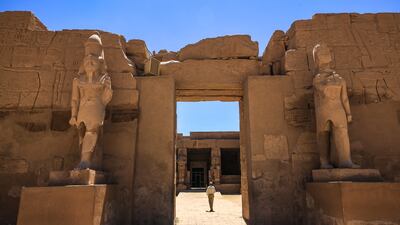Karnak temple, a Unesco World Heritage site near Luxor, was developed about 4,600 years ago after a group of elites used complex flooding techniques to create a place of worship, a study has found.
The temple complex, which welcomes millions of tourists a year, is considered one of the most significant in Egypt, but its origins have been a source of disagreement, even after 150 years of study.
It is located 500 metres east of the present-day River Nile near Luxor, at the ancient Egyptian religious capital of Thebes. It comprises a vast complex of temples, pylons and chapels and was added to the Unesco list in 1979.
While some archaeologists believed it was a "old" temple, built about 5,000 years ago, others thought it was considerably newer.
Now, the most comprehensive geoarchaeological survey has found it originated about 1,000 years later than that, as a dwelling place for a powerful god known as Ra-Amun.
It could not have been any older, as the site would have been unsuitable for permanent occupation due to regular flooding from the fast-flowing waters of the River Nile, the researchers found.
“This new research provides unprecedented detail on the evolution of Karnak Temple, from a small island to one of the defining institutions of ancient Egypt,” says Dr Ben Pennington, lead author of the paper and visiting fellow in geoarchaeology at the University of Southampton.
An international research team analysed 61 sediment cores from the temple site, as well as tens of thousands of ceramic fragments, to help date their findings, which are published in the journal Antiquity.
They have now mapped out how the landscape around the site changed throughout its history. The earliest occupation at Karnak would have likely been during the Old Kingdom, about 2591 BC to 2152 BC.
River channels became deeper, creating an island of high ground in what is now the east and south-eastern area of the complex.
The emerging island allowed for the temple to be constructed. As the river channels diverged, they created more space for the temple to be expanded.
Dominic Barker, another co-author also from the University of Southampton, added: “The river channels surrounding the site shaped how the temple could develop and where, with new construction taking place on top of old rivers as they silted up.”
“We also see how ancient Egyptians shaped the river itself, through the dumping of sands from the desert into channels, possibly to provide new land for building, for example.”
This development has striking similarities to an ancient Egyptian creation myth, leading the team to believe that the decision to locate the temple here could have been linked to the religious views of its inhabitants.
Ancient Egyptian texts of the Old Kingdom say that the creator god manifested as high ground, emerging from ‘the lake’. The island upon which Karnak was founded is the only known such area of high ground surrounded by water in the area.
“It’s tempting to suggest the Theban elites chose Karnak’s location for the dwelling place of a new form of the creator god, Ra-Amun, as it fitted the cosmogonical scene of high ground emerging from surrounding water,” says Dr Pennington.
“Later texts of the Middle Kingdom [about 1980 BC to 1760 BC) develop this idea, with the ‘primeval mound’ rising from the ‘Waters of Chaos’. During this period, the abating of the annual flood would have echoed this scene, with the mound on which Karnak was built appearing to ‘rise’ and grow from the receding floodwaters.”


